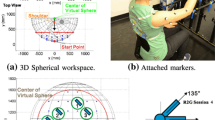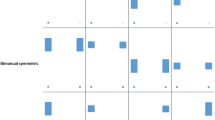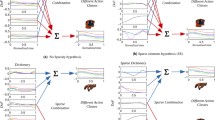Abstract
Reach-to-grasp actions are fundamental to the daily activities of human life, but few methods exist to assess individuals’ reaching and grasping actions in unconstrained environments. The Block Building Task (BBT) provides an opportunity to directly observe and quantify these actions, including left/right hand choices. Here we sought to investigate the motor and non-motor causes of left/right hand choices, and optimize the design of the BBT, by manipulating motor and non-motor difficulty in the BBT’s unconstrained reach-to-grasp task. We hypothesized that greater motor and non-motor (e.g. cognitive/perceptual) difficulty would drive increased usage of the dominant hand. To test this hypothesis, we modulated block size (large vs. small) to influence motor difficulty, and model complexity (10 vs. 5 blocks per model) to influence non-motor difficulty, in healthy adults (n = 57). Our data revealed that increased motor and non-motor difficulty led to lower task performance (slower task speed), but participants only increased use of their dominant hand only under the most difficult combination of conditions: in other words, participants allowed their performance to degrade before changing hand choices, even though participants were instructed only to optimize performance. These results demonstrate that hand choices during reach-to grasp actions are more stable than motor performance in healthy right-handed adults, but tasks with multifaceted difficulties can drive individuals to rely more on their dominant hand.






Similar content being viewed by others
References
Bagesteiro LB, Sainburg RL (2002) Handedness: dominant arm advantages in control of limb dynamics. J Neurophysiol 88:2408–2421
Baumard J, De Sousa E, Roy V, Deschamps L, Iodice P, Osiurak F, Brisson J (2023) Grip selection without tool knowledge: end-state comfort effect in familiar and novel tool use. Exp Brain Res 241:1989–2000. https://doi.org/10.1007/s00221-023-06655-0
Bootsma JM, Hortobágyi T, Rothwell JC, Caljouw SR (2018) The role of task difficulty in learning a visuomotor skill. Med Sci Sports Exerc 50:1842–1849
Bryden PJ (2016) The influence of M. P. Bryden’s work on lateralization of motor skill: is the preferred hand selected for and better at tasks requiring a high degree of skill? Laterality 21:312–328. https://doi.org/10.1080/1357650X.2015.1099661
Bryden PJ, Mayer M, Roy EA (2011) Influences of task complexity, object location, and object type on hand selection in reaching in left and right-handed children and adults. Dev Psychobiol 53:47–58. https://doi.org/10.1002/dev.20486
Corey DM, Hurley MM, Foundas AL (2001) Right and left handedness defined: a multivariate approach using hand preference and hand performance measures. Cogn Behav Neurol 14:144–152
Flindall JW, Doan JB, Gonzalez CLR (2014) Manual asymmetries in the kinematics of a reach-to-grasp action. Laterality 19:489–507. https://doi.org/10.1080/1357650X.2013.862540
Friard O, Gamba M (2016) BORIS: a free, versatile open-source event‐logging software for video/audio coding and live observations. Methods Ecol Evol 7:1325–1330
Gabbard C, Rabb C (2000) What determines choice of limb for unimanual reaching movements? J Gen Psychol 127:178–184
Gonzalez CL, Goodale MA (2009) Hand preference for precision grasping predicts language lateralization. Neuropsychologia 47:3182–3189
Gonzalez CLR, Ganel T, Goodale MA (2006) Hemispheric specialization for the visual control of action is independent of handedness. J Neurophysiol 95:3496–3501. https://doi.org/10.1152/jn.01187.2005
Gonzalez CL, Whitwell RL, Morrissey B, Ganel T, Goodale MA (2007) Left handedness does not extend to visually guided precision grasping. Exp Brain Res 182:275–279. https://doi.org/10.1007/s00221-007-1090-1
Hadfield JD (2010) MCMC methods for multi-response generalized linear mixed models: the MCMCglmm R package. J Stat Softw 33:1–22
Harris PA, Taylor R, Thielke R, Payne J, Gonzalez N, Conde JG (2009) Research electronic data capture (REDCap)—a metadata-driven methodology and workflow process for providing translational research informatics support. J Biomed Inform 42:377–381. https://doi.org/10.1016/j.jbi.2008.08.010
Israely S, Carmeli E (2017) Handwriting performance versus arm forward reach and grasp abilities among post-stroke patients, a case-control study. Top Stroke Rehabil 24:5–11. https://doi.org/10.1080/10749357.2016.1183383
Janssen L, Beuting M, Meulenbroek R, Steenbergen B (2009) Combined effects of planning and execution constraints on bimanual task performance. Exp Brain Res 192:61–73. https://doi.org/10.1007/s00221-008-1554-y
Janssen L, Meulenbroek RGJ, Steenbergen B (2011) Behavioral evidence for left-hemisphere specialization of motor planning. Experimental Brain Res Experimentelle Hirnforschung Expérimentation cérébrale 209:65–72. https://doi.org/10.1007/s00221-010-2519-5
Kim S, Han CE, Kim B, Winstein CJ, Schweighofer N (2020) Arm choice post-stroke is habitual rather than optimal in right-, but not in left-paretic individuals. medRxiv:2020.2008. 2031.20185389
Klein LK, Maiello G, Fleming RW, Voudouris D (2021) Friction is preferred over grasp configuration in precision grip grasping. J Neurophysiol 125:1330–1338
Leconte P, Fagard J (2006) Which factors affect hand selection in children’s grasping in hemispace? Combined effects of task demand and motor dominance. Brain Cogn 60:88–93. https://doi.org/10.1016/j.bandc.2005.09.009
Lee-Feldstein A, Harburg E (1982) Alcohol use among right-and left-handed persons in a small community. J Stud Alcohol 43:824–829
Liang J, Wilkinson K, Sainburg RL (2018a) Is hand selection modulated by cognitive–perceptual load? Neuroscience 369:363–373
Liang J, Wilkinson KM, Sainburg RL (2018b) Cognitive-perceptual load modulates hand selection in left-handers to a greater extent than in right-handers. Exp Brain Res 237:389–399. https://doi.org/10.1007/s00221-018-5423-z
Mamolo CM, Roy EA, Bryden PJ, Rohr LE (2004) The effects of skill demands and object position on the distribution of preferred hand reaches. Brain Cogn 55:349–351. https://doi.org/10.1016/j.bandc.2004.02.041
Mani S, Mutha PK, Przybyla A, Haaland KY, Good DC, Sainburg RL (2013) Contralesional motor deficits after unilateral stroke reflect hemisphere-specific control mechanisms. Brain 136:1288–1303
Mutha PK, Haaland KY, Sainburg RL (2012a) The effects of brain lateralization on motor control and adaptation. J Mot Behav 44:455–469
Mutha PK, Haaland KY, Sainburg RL (2012b) The effects of brain lateralization on motor control and adaptation. J Mot Behav 44:455–469. https://doi.org/10.1080/00222895.2012.747482
Oldfield RC (1971) The assessment and analysis of handedness: the Edinburgh inventory. Neuropsychologia 9:97–113
Pacilli A, Germanotta M, Rossi S, Cappa P (2014) Quantification of age-related differences in reaching and circle-drawing using a robotic rehabilitation device. Appl Bionics Biomech 11:91–104
Papadatou-Pastou M, Ntolka E, Schmitz J, Martin M, Munafo MR, Ocklenburg S, Paracchini S (2020) Human handedness: a meta-analysis. Psychol Bull 146:481–524. https://doi.org/10.1037/bul0000229
Paulun VC, Kleinholdermann U, Gegenfurtner KR, Smeets JB, Brenner E (2014) Center or side: biases in selecting grasp points on small bars. Exp Brain Res 232:2061–2072. https://doi.org/10.1007/s00221-014-3895-z
Philip BA, Frey SH (2014) Compensatory changes accompanying chronic forced use of the nondominant hand by unilateral amputees. J Neurosci 34:3622–3631
Philip BA, Frey SH (2016) Increased functional connectivity between cortical hand areas and praxis network associated with training-related improvements in non-dominant hand precision drawing. Neuropsychologia 87:157–168
Philip BA, Kaskutas V, Mackinnon SE (2020) Impact of handedness on disability after unilateral upper-extremity peripheral nerve disorder. Hand 15:327–334
Philip BA, McAvoy MP, Frey SH (2021) Interhemispheric parietal-frontal connectivity predicts the ability to acquire a nondominant hand skill. Brain Connect 11:308–318
Philip BA, Thompson MR, Baune NA, Hyde M, Mackinnon SE (2022a) Failure to compensate: patients with nerve Injury Use their injured Dominant Hand, even when their nondominant is more dexterous. Arch Phys Med Rehabil 103:899–907. https://doi.org/10.1016/j.apmr.2021.10.010
Philip BA, Thompson MR, Baune NA, Hyde M, Mackinnon SE (2022b) Failure to compensate: patients with nerve Injury Use their injured Dominant Hand, even when their nondominant is more dexterous. Arch Phys Med Rehabil 103:899–907
Philip BA, Li F, Hawkins-Chernof E, Chen L, Swamidass V, Zwir I (2023) Motor Assessment with the STEGA iPad app to measure handwriting in children. Am J Occup Therapy 77:7703205010
Przybyla A, Coelho CJ, Akpinar S, Kirazci S, Sainburg RL (2013) Sensorimotor performance asymmetries predict hand selection. Neuroscience 228:349–360. https://doi.org/10.1016/j.neuroscience.2012.10.046
Randerath J, Li Y, Goldenberg G, Hermsdörfer J (2009) Grasping tools: effects of task and apraxia. Neuropsychologia 47:497–505. https://doi.org/10.1016/j.neuropsychologia.2008.10.005
Rosenbaum DA (1980) Human movement initiation: specification of arm, direction, and extent. J Exp Psychol Gen 109:444
Sainburg RL (2002) Evidence for a dynamic-dominance hypothesis of handedness. Exp Brain Res 142:241–258
Sauseng P, Griesmayr B, Freunberger R, Klimesch W (2010) Control mechanisms in working memory: a possible function of EEG theta oscillations. Neurosci Biobehavioral Reviews 34:1015–1022
Scharoun SM, Scanlan KA, Bryden PJ (2016) Hand and grasp selection in a preferential reaching task: the effects of object location, orientation, and task intention. Front Psychol 7:360
Schweighofer N, Xiao Y, Kim S, Yoshioka T, Gordon J, Osu R (2015) Effort, success, and nonuse determine arm choice. J Neurophysiol 114:551–559
Stelmach GE (2014) Information processing in motor control and learning. Academic
Stoloff RH, Taylor JA, Xu J, Ridderikhoff A, Ivry RB (2011) Effect of reinforcement history on hand choice in an unconstrained reaching task. Front Neurosci 5:41. https://doi.org/10.3389/fnins.2011.00041
Stone KD, Gonzalez CL (2014) Grasping with the eyes of your hands: hapsis and vision modulate hand preference. Exp Brain Res 232:385–393. https://doi.org/10.1007/s00221-013-3746-3
Stone KD, Gonzalez CL (2015) Manual preferences for visually- and haptically-guided grasping. Acta Psychol (Amst) 160:1–10. https://doi.org/10.1016/j.actpsy.2015.06.004
Stone KD, Bryant DC, Gonzalez CL (2013) Hand use for grasping in a bimanual task: evidence for different roles? Exp Brain Res 224:455–467. https://doi.org/10.1007/s00221-012-3325-z
Voudouris D, Smeets JB, Brenner E (2012) Do humans prefer to see their grasping points? J Mot Behav 44:295–304. https://doi.org/10.1080/00222895.2012.703975
Wojtkiewicz DM, Saunders J, Domeshek L, Novak CB, Kaskutas V, Mackinnon SE (2015) Social impact of peripheral nerve injuries. Hand 10:161–167
Wolpert DM, Landy MS (2012) Motor control is decision-making. Curr Opin Neurobiol 22:996–1003. https://doi.org/10.1016/j.conb.2012.05.003
Acknowledgements
This work was funded by NIH/NINDS R01 NS114046 to BAP. The authors would like to thank Summer Fletcher for their help with data collection; and Xinye Wu, Jackie Hardy, Summer Fletcher, Delaney McIntyre, Tina Nguyen, Rachel Graves, and Elizabeth Magee for their help with video coding.
Author information
Authors and Affiliations
Corresponding author
Ethics declarations
Dr. Philip and Washington University in St. Louis have a licensing agreement with PlatformSTL to commercialize the iPad app used in this study.
Additional information
Communicated by Winston D Byblow.
Publisher’s Note
Springer Nature remains neutral with regard to jurisdictional claims in published maps and institutional affiliations.
Rights and permissions
Springer Nature or its licensor (e.g. a society or other partner) holds exclusive rights to this article under a publishing agreement with the author(s) or other rightsholder(s); author self-archiving of the accepted manuscript version of this article is solely governed by the terms of such publishing agreement and applicable law.
About this article
Cite this article
Kim, T., Zhou, R., Gassass, S. et al. Healthy adults favor stable left/right hand choices over performance at an unconstrained reach-to-grasp task. Exp Brain Res (2024). https://doi.org/10.1007/s00221-024-06828-5
Received:
Accepted:
Published:
DOI: https://doi.org/10.1007/s00221-024-06828-5




